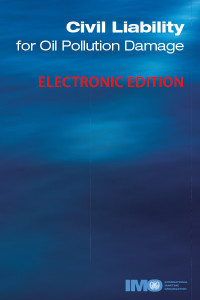
This publication is a guide to the preparation of shipboard marine pollution emergency plans.
This publication contains guidelines for the development of shipboard oil pollution emergency plans (SOPEP) and shipboard marine pollution emergency plans for oil and/or noxious liquid substances (SMPEP). It is designed to assist in meeting MARPOL requirements.
The International Convention for the Prevention of Pollution from Ships, 1973, as modified by the Protocols of 1978 and 1997 relating thereto (MARPOL), is the principal instrument established by IMO for preventing marine pollution. Regulation 37 of Annex I of this Convention requires that every oil tanker of 150 tons gross tonnage and above and every ship other than an oil tanker of 400 tons gross tonnage and above carry on board a shipboard oil pollution emergency plan approved by the Administration. It is pertinent to note that MARPOL was amended to include the above-mentioned regulation 37 of Annex I as a consequence of article 3(1)(a) of the International Convention on Oil Pollution Preparedness, Response and Co-operation (OPRC), 1990. This Convention contains a requirement that certain ships have on board a shipboard oil pollution emergency plan. The shipboard plan required under regulation 37 of Annex I of MARPOL is the same shipboard oil pollution emergency plan that is required under article 3(1)(a) of the OPRC Convention.
Regulation 17 of Annex II of MARPOL requires that every ship of 150 tons gross tonnage and above certified to carry noxious liquid substances in bulk carry on board a shipboard marine pollution emergency plan for noxious liquid substances approved by the Administration. A shipboard marine pollution emergency plan for noxious liquid substances may be combined with a shipboard oil pollution emergency plan, since most of their contents are the same and one combined plan on board is more practical than two separate plans in case of an emergency. In this case the title of such a combined plan should be ‘‘Shipboard marine pollution emergency plan’’ in order to distinguish it from a shipboard marine pollution emergency plan for noxious liquid substances and a shipboard oil pollution emergency plan. Both regulation 37 of Annex I and regulation 17 of Annex II require that the plans be in accordance with guidelines developed by IMO.
The Marine Environment Protection Committee (MEPC) at its 32nd session adopted Guidelines for the development of shipboard oil pollution emergency plans by resolution MEPC.54(32) to meet the requirements of regulation 37 of Annex I. At its 44th session, it prepared Guidelines for the development of shipboard marine pollution emergency plans to meet the requirements of regulation 37 of Annex I and/or regulation 17 of Annex II on the basis of the guidelines for oil (resolution MEPC.85(44)).
As a result of this review, amendments to the Guidelines for the development of shipboard oil pollution emergency plans were also prepared by the MEPC at the same session to ensure uniform application of these regulations and guidelines (resolution MEPC.86(44). It is pertinent to note that shipboard oil pollution emergency plans approved by an Administration for oil tankers of 150 tons gross tonnage and above and ships other than oil tankers of 400 tons gross tonnage and above in accordance with the Guidelines for the development of shipboard oil pollution emergency plans adopted by resolution MEPC.54(32) need not be modified in accordance with either these Guidelines or the Guidelines for the development of shipboard marine pollution emergency plans for oil and/or noxious liquid substances adopted by resolution MEPC.85(44).
Further amendments to the Guidelines for the development of shipboard marine pollution emergency plans for oil and/or noxious liquid substances were introduced by the Marine Environment Protection Committee at its 53rd session in order to reflect changes arising from revisions to MARPOL which entered into force on 1 January 2007. In the latter context, in accordance with MEPC/Circ.421, updated regulation numbers for MARPOL Annex I have also now been incorporated into the Guidelines for the development of shipboard oil pollution emergency plans as set out in this edition.
Under the provisions of article 5 of the 1973 MARPOL Convention, a ship is required to hold a certificate in accordance with the provisions of regulations and, while in the ports or offshore terminals under the jurisdiction of a Party, is subject to inspection by officers duly authorized by that Party. In this context, the carriage of an appropriate shipboard marine pollution emergency plan should also be subject to such inspection.
These Guidelines contain information for the preparation of shipboard marine pollution emergency plans.
The main objectives of these Guidelines are:
- to assist shipowners in preparing shipboard marine pollution emergency plans in conformity with the cited regulations; and
- to assist Governments in developing and enacting domestic laws which give force to and implement the cited regulations.
In the interest of uniformity, Governments are requested to refer to these Guidelines when preparing appropriate national regulations.
Guidelines for the development of shipboard oil pollution emergency plans
Section 1 – Introduction
Section 2 – Mandatory provisions of regulation 37 of Annex I of the Convention
Section 3 – Non-mandatory provisions
Appendix I: Additional references for the development of shipboard oil pollution emergency plans
Appendix II: Example format for shipboard oil pollution emergency plan
Guidelines for the development of shipboard marine pollution emergency plans for oil and / or noxious liquid substances
Section 1 – Introduction
Section 2 – Mandatory provisions of regulation 37 of Annex I and regulation 17 of Annex II to the Convention
Section 3 – Non-mandatory provisions
Appendix I: Additional references for the development of shipboard marine pollution emergency plans
Appendix II: Example format for a shipboard marine pollution emergency plan (for oil and/or noxious liquid substances)
Appendix
Resolution MEPC.54 (32)
Resolution MEPC.86 (44)
Annex I of MARPOL, as amended:
Regulation 37 – Shipboard oil pollution emergency plan
Unified interpretation of regulation 37.I
MEPC / Circ.421
Resolution MEPC.85 (44)
Annex II of MARPOL as amended:
Regulation 17 – Shipboard marine pollution emergency plan for noxious liquid substances
Resolution MEPC.137 (53)
A??s a specialised agency of the United Nations, IMO is the global standard-setting authority for the safety, security and environmental performance of international shipping. Its main role is to create a regulatory framework for the shipping industry that is fair and effective, universally adopted and universally implemented.
In other words, its role is to create a level playing-field so that ship operators cannot address their financial issues by simply cutting corners and compromising on safety, security and environmental performance. This approach also encourages innovation and efficiency.
Shipping is a truly international industry, and it can only operate effectively if the regulations and standards are themselves agreed, adopted and implemented on an international basis. And IMO is the forum at which this process takes place.
- Number of Pages:
- 70
- ISBN:
- 9789280115185
- Published Date:
- April 2010
- Book Height:
- 210 mm
- Book Width:
- 150 mm
- Author:
IMO
- Binding Format:
- Paperback
- Preview:
- Yes
- Publication Date:
- April 2010





